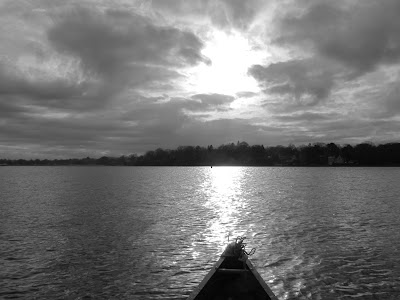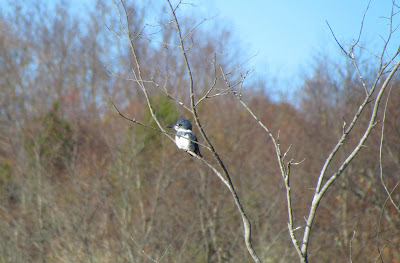The wind is out of the north and east today, which is something that I don't think of as normal, while being full aware that I haven't been here long enough to know what normal is. I put in at the harbor noting first that most of the floating docks and nearly all of the pleasure boats have been pulled from the water - a winter warning, I suppose. But, right now it is as calm here as I have ever seen it and my paddle out to the ocean is nothing but gentle.
The sky is cloudy, but the clouds move with haste and the sun shows through every once in awhile. The work boats, oystermen who are actually harvesting clams, are working the waters between the mainland and Charles Island. It is not normal for me to see them there. The near ocean waters, being in the lee of the shoreline are calm and so, instead of heading straight into Gulf Pond, I continue east along land that I have not seen before. People along here are rebuilding rock walls that were damaged during the hurricane, but I suspect that most of their damage was erosion and not structure. I can see occasional whitecaps out beyond Welches Point and when I get there I find the wind to be not impossible, but not inviting. There seems no good reason to leave the gentle waters. I turn back noticing the large and exposed house that sits at the point, the former site of a guano and fishmeal factory.
I pass under the rusty bridge at slack tide, the peak of high tide when everything stands still for a few moments before reversing direction. There is absolutely no current as I duck under the rusted beams. A bit of north wind puts some effort into the paddle up Gulf Bay. I spot black ducks, buffleheads, Canada geese and one great blue heron.
The real surprise, the real not normal event for me comes at the stone railroad bridge. It is the gate into the Indian River. I have seen it at low tide when it must be waded and the canoe lined through. I have been here somewhere near high tide when a deep overpowering flow comes out. Today, through no fault of my own, I slip effortlessly under the bridge, the high tide of Gulf Pond matching the high tide in Indian River.
I have never been in the river while it is high tide, so I continue past the time when I would've normally turned back. The river is full width and unconstrained. I spot some more black ducks and buffleheads and three hooded mergansers that takeoff around the next bend just as we see each other. That's mostly normal for them. Under the highway bridge I find a raccoon. I knew they were here, but this is the first that I've seen.
I watch the water mark on the grasses and reeds that line the river. When I turn back, the water has dropped about 2 inches and there is now a small current. At the stone bridge the water has now dropped 3 inches and I coast through riding on the tide.
nocturnal
6 days ago



































